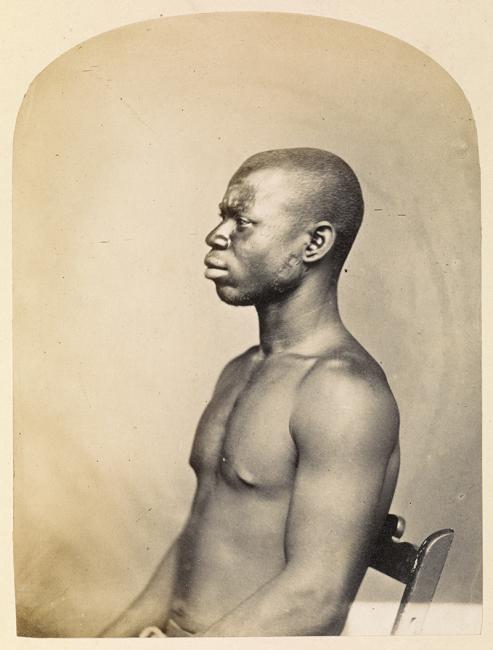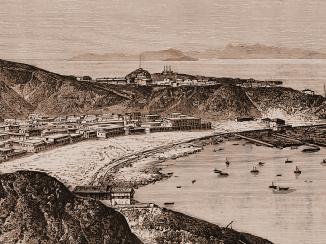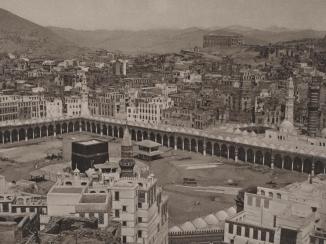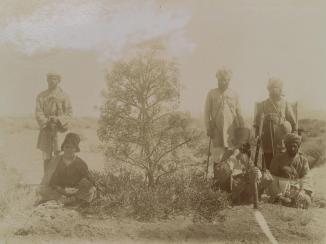Overview
‘Turkish official’, ‘prominent merchant’, ‘Circassian slave’, ‘muezzin’: the captions beneath the portraits in Christiaan Snouck Hurgronje’s Bilder-Atlas zu Mekka attempt to depict society in Mecca in the 1880s from a structural and hierarchical point of view.
But many of the photographs published in the album were not taken by Snouck Hurgronje, rather by his one-time working partner, al-Sayyid ‘Abd al-Ghaffār. What’s more, Snouck Hurgronje changed ‘Abd al-Ghaffār’s photographs before publication, using stencils to remove decorative backgrounds and erasing inscriptions that described the subjects of his photographs.
The removal of such elements reveals a difference between ‘Abd al-Ghaffār’s and Snouck Hurgronje’s approach to photographic portraiture. Equally, it is interesting to consider how such backgrounds and inscriptions might have influenced a contemporary impression of the images upon their publication in Europe in 1888.
Portraiture and the Construction of Realities
As a Western photographer seeking to document ‘Oriental’ subjects, Snouck Hurgronje was not interested in the type of portraiture where the sitter participates in or leads in constructing any given reality, for example by dictating their pose, dress and props. This approach was capable of producing tensions between the photographer and subject, where both could control the sitting for a photograph to a greater or lesser degree: where the photographer holds more power over the depiction of the sitter, the sitter holds less, and vice-versa.
Snouck Hurgronje considered himself a neutral observer – akin to today’s documentary photographers. Moreover, his interest lay in compiling an encyclopaedic record of Meccan life. The portraits he produced had to serve as visual records that supported his written account of Meccan society, and in general, as evidence of the neutrality of Western, ethnographic study.
Neutrality and Ethnographic Portraiture
The notion of the neutrality of ethnographic photography denies the construction of realities, frequently by imposing a scientific veneer over ethnographic portraiture. Portraits that measure parts of the human body are known as anthropometric portraits: instruments and apparatus, such as callipers and measuring sticks were photographed alongside the subject. Alternatively, the subject was photographed before a ‘Lamprey grid’, a black panel divided into regular two inch squares by vertical and horizontal threads.

Snouck Hurgronje did not use these anthropometric poses or props in the portraits he took of pilgrims at Jeddah, because he did not wish to reveal his intention to his sitters and, according to Durkje van der Wal, ‘deliberately said nothing about his scholarly interests, believing that, by western standards, Arabs had no understanding or appreciation of research’. But it was also not in his interest to photograph sitters alongside cultural props that implied an individual’s relative modernity, personality or exposure to Westernization. This would interfere with his attempt to depict Meccan life as ‘that singular society’.
Snouck Hurgronje was interested in portraying ‘types’ rather than individuals, writing ‘for the past few weeks I have been occupied solely in questioning these people […] insofar as they are typical enough to be photographed’. A portrait of a named individual from Mecca would not be of interest to an ethnographer whereas a portrait of a sweet-seller was. The difference lies in the transition from the individual to the archetypal: the sweet-seller is simultaneously of his time and place, but decontextualized to the extent that his individual personhood is irrelevant.
![Snouck Hugronje didn’t always remove the backgrounds in his portraits. Here a sweet-seller is portrayed as one amongst a myriad different ‘types’ in Jeddah. Süssigkeitskrämer [sweet-seller] by Christian Snouck Hurgronje, ca. 1888. 1781.b.6/55](https://www.qdl.qa/sites/default/files/styles/standard_content_image/public/1781.b.6_0096_cropped.jpg?itok=g3lm0XBp)
‘Abd al-Ghaffār’s Approach
In contrast to Snouck Hurgronje, ‘Abd al-Ghaffār was interested in delivering good quality portraits for commercial purposes, especially since his clients included such powerful figures as Aun er-Rafiq, the Grand Scharif of Mecca. He depicted his sitters as individuals, standing on richly woven carpets, before ornate, painted backgrounds or surrounded by props that told of their relative wealth and modernity. When ‘Abd al-Ghaffār sent Snouck Hurgronje his portraits of individuals against ornate painted backgrounds or alongside props, the latter felt he needed to intervene.
![Here the merchant remains unnamed, while the novelty of his circassian slave comes to the fore. ‘Vornehmner Kaufmann mit seinem cirkassischen Sklaven’ [Distinguished merchant and his circassian slave] by Christiaan Snouck Hugronje, ca. 1888. 1781.b.6/11](https://www.qdl.qa/sites/default/files/styles/standard_content_image/public/1781.b.6_0039_cropped.jpg?itok=VOu8ES5n)
Snouck Hurgronje never revealed to ‘Abd al-Ghaffār how he planned to present the photographs he commissioned; perhaps because he understood that those keen to protect Islam’s holiest city would be concerned at the idea of an encyclopaedic ‘Atlas’ of Mecca being published in the West. But his insistence on hiding the intention behind his photography caused him difficulties. He sought ‘good portraits of races and nations of every kind’ but struggled to convince ‘Abd al-Ghaffār to photograph slaves, women and the lower classes, who, according to correspondence between the two men, were equally reluctant to be photographed.
The fact that ‘Abd al-Ghaffār operated a studio before Snouck Hugronje’s arrival makes clear that a ready market for portrait photography existed in the 1880s in Mecca, most likely amongst a more liberal elite interested in the novelty of portraiture. Inevitably then, ‘Abd al-Ghaffār’s photographs were caught between the evolving genre of Ottoman portraiture and Snouck Hurgronje’s requirements (‘without a flowerpot, books etc.’) for ethnographic portraiture; they are strange hybrids, the names of their subjects obscured by generic captions, suspended within their characterisations: ‘eunuch’, ‘crier and broker’, ‘sweet-seller’.




